
Will Obama take on food?
By Ann Vileisis / On November 19th, 2008
In the months leading up to the election, food activists (see the video by The White House Organic Farm Project, a.k.a. TheWhoFarm.org below) have been salivating over the possibility that they could convince the next president to turn up some sunny expanse of White House lawn and put in a lush and leafy organic farm. The bounty of veggies could feed not only the first family but also Washington's needy and fresh-food-deprived school children.

